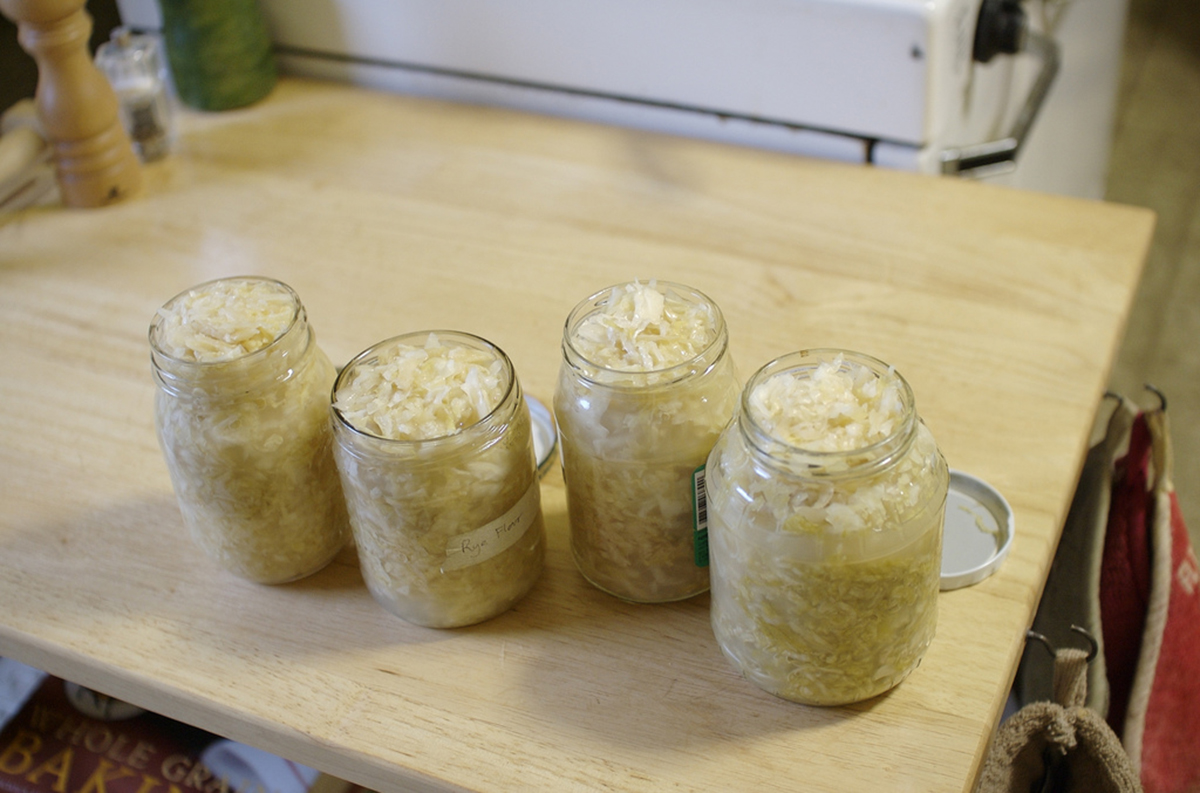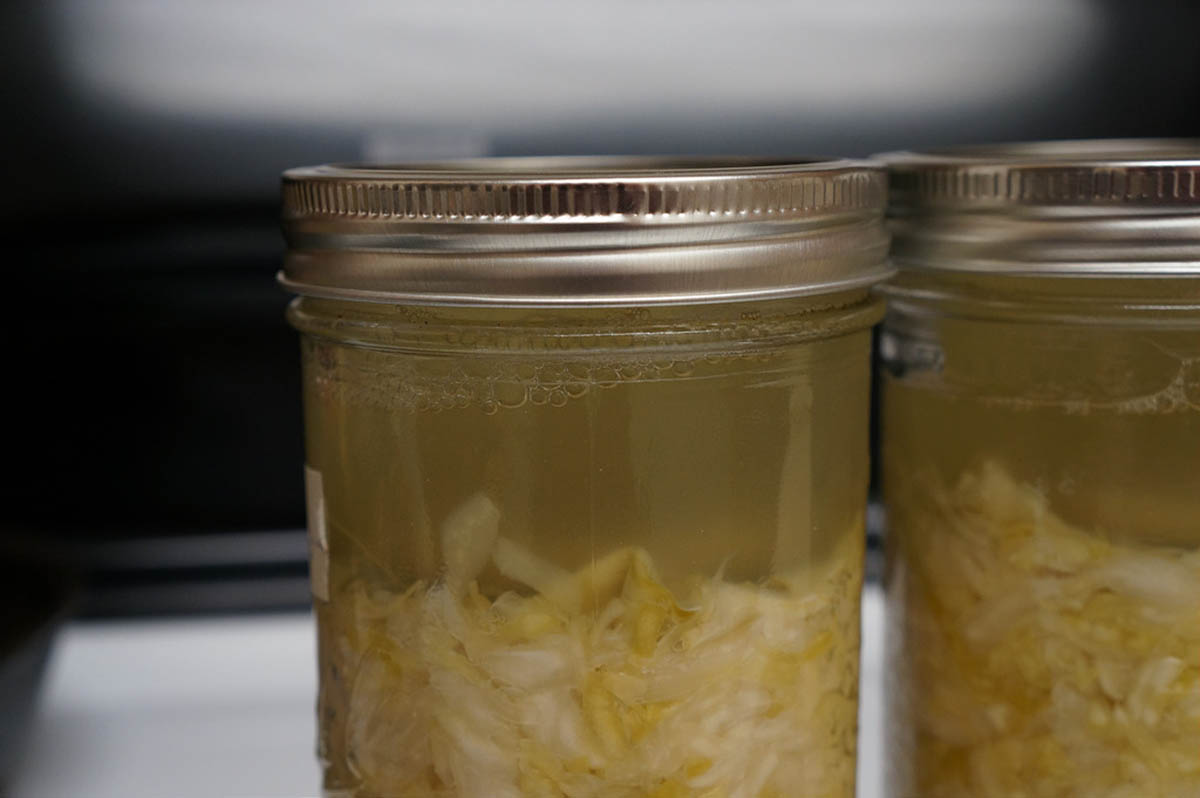Cabbage provides more medicinal value than any other food available to us. It was brought to Europe around 600 B.C. in the form of wild cabbage, similar to kale and collards. Nobody is sure how and when exactly we got the heads of cabbage that we’re familiar nowadays, but we know that cultivation of wild cabbage started in Northern Europe and spread throughout Russia, Poland and Germany. Early German settlers brought both cabbage and the recipe to prepare sauerkraut to the New World.
Sauerkraut is not only a delicious wintertime condiment, but also a real storehouse of vitamins and minerals. It’s basically a fermented cabbage, very easy to make. You shred the cabbage, add salt and leave everything to ferment for a while. Sauerkraut has a long shelf life; it can survive without refrigeration for several months.

Nutritional Value
Sauerkraut is full of fiber, B, C and K vitamins. It also contains some iron, manganese, copper, and magnesium, as well as calcium. One serving gives you roughly 30% of the recommended daily amount of vitamin C. This is amazing, since vitamin C is the number one go-to antioxidant. It fights free radicals and boosts the immune system, among many other benefits. It’s basically a shield for our bodies from all the toxins we encounter on daily basis, preventing cell damage, and helping our skin to produce collagen.
Vitamin K is essential for good bone and teeth health because it helps the body to regulate where the calcium goes. Vitamin K directs the calcium to go where it’s most needed. It can’t be emphasized enough how important vitamin K is. Besides its contribution to the health of bone tissue, it’s extremely beneficial against cancer, and it limits damage to brain cells which often leads to Alzheimer’s disease.
READ Cabbage: The Overlooked Superfood
Last, but not least, and this is the most obvious benefit… Because it’s fermented, sauerkraut is a potent source of probiotics. Probiotics are the good bacteria that reside in your intestines. The gut is the place where most of the immune system resides, so it’s extremely important to keep the gut flora healthy and balanced. These bacteria help to keep the body healthy from any possible toxic food that enters the body, and of course, aid digestion.
In the second part of the article, we’ll talk more about the benefits of pickling and provide a recipe for a healthy and easy to make condiment that you’ll love. It’s very important to think about your health. Always aim to make your own salads and condiments, rather than buying already prepared pasteurized ones full of preservatives. Fermented or not, cabbage is amazing and we should consume it as much as possible.
More Benefits Of Cabbage (Raw And Fermented)
There are three basic kinds of cabbage: savoy, green and red. Green and red cabbage both have smooth leaves and a crunchy texture, while savoy cabbage has ruffled leaves, and its texture is more delicate. When purchasing cabbage, look for a dense and firm heads. Leaves should be without blemishes.

Even though we talked about the health benefits of cruciferous vegetables many times before, it’s important to mention the amazing benefits of cabbage, both fresh and pickled, one more time. Everyone knows that cabbage is full of vitamin C (even more than an orange per serving). It is also rich in phytonutrients, above all anthocyanins and polyphenols. These nutrients help to reduce chronic inflammations and oxidative stress, thereby preventing cardiovascular diseases and several forms of cancer, including colon, breast and prostate cancer.
Cabbage is also full of glucosinolates, nutrients specific to the cruciferous family of vegetables. These nutrients, together with glutamine and polyphenols aid digestive health. They help to prevent stomach ulcers, and sometimes even cure them in their advanced stages.
Sauerkraut Recipe
You can use both green and red cabbage for this recipe, and it will be enough for two liters of sauerkraut. You will need:
- 4 heads of cabbage
- 5-6 big carrots
- Handful of onion
- Some ginger
- 3 tablespoons of salt
- Any other desired veggie (we’re using 3 green chili peppers)
Discard 2-3 outer leaves from the cabbage if needed, you will know by just looking at it. Also, set aside 3-4 good leaves, we’ll need them for later. Slice the cabbage thinly. When you’re done slicing all of the heads, place it in a clean stainless-steel pot. Sprinkle some salt and leave it covered for a while.
READ How Kimchi Can Make You Healthier
Grate the carrots and chop the peppers or any other desired veggie. Add grated garlic on top. Mix everything well and add the rest of the salt. Take a wooden pounder and start mashing the ingredients. Do it for at least five minutes, as it will release all the juices from the vegetables and we’ll have to add less water. After 5-6 minutes, start packing the vegetables into a clean mason jar. The best way to do it is to add the veggies little by little, and press well with the pander every time you add some. This is done to release even more juice.
Put the clean cabbage leaves that you set aside before on top of each jar. This is done to keep all the vegetable pieces under water. Leave the jars undisturbed between a week and a month, it depends how fermented you like the sauerkraut to be.
Why Pickle?
By pickling the vegetables, we preserve all important nutrients and vitamins to last throughout winter. You can buy already fermented vegetables in shops, but they’re mostly pasteurized, so you don’t get any health benefits, only taste. When fermenting veggies, try using organically grown plants!
Even though the main ingredient of sauerkraut is cabbage, you can add many other items such as carrots, onion, garlic, ginger, or any kind of pepper. The only important thing is to keep cabbage a base.
We hope we made it clear how important eating cabbage, both raw and pickled, is. While eating fresh cabbage is great for our health, making and eating sauerkraut is even better, because the fermentation process helps the good bacteria to multiply.
- Photo courtesy of Joe Photo: www.flickr.com/photos/18474854@N00/3114969148/
- Photo courtesy of ccbarr: www.flickr.com/photos/ccbarr/17179747872/
- Photo courtesy of ccbarr: www.flickr.com/photos/ccbarr/17179747872/

